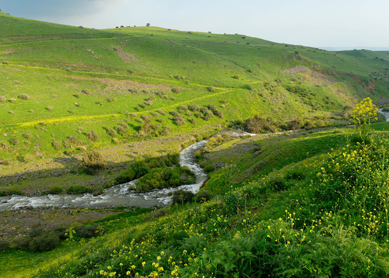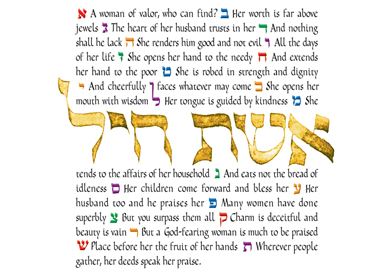Today, the Jordan River is little more than a trickle because the nations on either side of it (Israel, the Palestinian Territories, and Jordan) use much of its water to support their populations. But in ancient times, the river could be so swollen by spring rains that it could not be crossed (see, for example, Josh 3:15). Most of the year, however, the river was easily forded at several locations, even if its topographic and ecological features evoked images of a harsh and difficult landscape, sometimes even viewed as mythologically dangerous.
Several plant species, including willow and tamarisk, inhabit the innermost riverbed, forming a nearly impenetrable thicket. This thicket was commemorated as the ga’on (literally, “swelling,” or, metaphorically, “pride”) of the Jordan in Israelite poetry. The prophet Jeremiah compared the Jordan’s lush and difficult copse to open terrain, asking, “if in a safe land you fall down, how will you fare in the thickets of the Jordan?” (Jer 12:5). The Jordan’s thickets also served as the dwelling of lions (Zech 11:3), providing a fearsome image to which Jeremiah compares Yahweh’s swift action against Israel’s enemies (Jer 49:19, Jer 50:44). The same Hebrew word, ga’on, underlies the description of papyrus along riverbanks in Job 8:11.
The word “pride,” however, does not simply present a straightforward image of the Jordan’s thickets. In addition to this meaning, the Hebrew root also means “haughtiness” and “arrogance,” attributed sometimes to humans (for example, Isa 2:12, Jer 48:29) but also to enemies of a more sinister and mythic scope. In Job 10:16, the lion’s “bold” hunting is derived from this root, and in Ps 89:9 (Hebrew, verse 10), the sea itself is said to exhibit ge’ut, “raging.” Only when attributed to Yahweh does this root mean something admirable; for example, in Exod 15, the root is often translated as “triumphed gloriously” and “majesty,” indicating Yahweh’s fearsomeness (see also Isa 2:10-21).
The Jordan River, with its lush “pride,” could also be associated with the margins of civilization, as in Ps 42:6-7 (Hebrew, verses 7-8), where the psalmist “remember[s Yahweh], from the land of Jordan and of Hermon, from Mount Mizar.” Immediately following the geographical note, the poem moves to a tone of more mythic dimensions:
Deep (tehom) calls to deep
at the thunder of your cataracts;
all the waves and your billows
have gone over me. (Ps 42:7 [Hebrew, verse 8])
In Hebrew, the word tehom frequently pointed toward the mythic foundations of the world, which Yahweh had subdued while establishing cosmic order (see, for example, Gen 1:2, Gen 7:11, Isa 51:10, Ezek 31:4, Ezek 31:15). The mythic features of the Jordan are heightened in Job 40:23, which associates it with the mythological beast Behemoth. Finally, the Jordan River also undergoes personification in Ps 114, where the Jordan River “turns back” (Ps 114:3-5) upon having seen the approach of the people Israel, accompanied by Yahweh.



